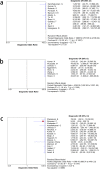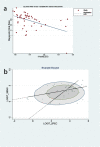MPT64 assays for the rapid detection of Mycobacterium tuberculosis
- PMID: 33838648
- PMCID: PMC8035777
- DOI: 10.1186/s12879-021-06022-w
MPT64 assays for the rapid detection of Mycobacterium tuberculosis
Abstract
Background: Tuberculosis (TB) is a serious infectious disease caused by Mycobacterium tuberculosis (MTB). An estimated 1.7 billion people worldwide are infected with Mycobacterium tuberculosis (LTBI) during the incubation period without any obvious symptoms. Because of MTB's high infection and mortality rates, there is an urgent need to develop a fast, portable, and sensitive diagnostic technology for its detection.
Methods: We included research from PubMed, Cochrane Library, Web of Science, and Embase and extracted the data. MetaDisc and STATA were used to build forest plots, Deek's funnel plot, Fagan plot, and bivariate boxplot for analysis.
Results: Forty-six articles were analyzed, the results of which are as follows: sensitivity and specificity were 0.92 (0.91-0.93) and 0.95 (0.94-0.95) respectively. The NLR and PLR were 0.04 (95% CI 0.03-0.07) and 25.32 (95% CI 12.38-51.78) respectively. DOR was 639.60 (243.04-1683.18). The area under the SROC curve (AUC) was 0.99.
Conclusions: MPT64 exhibits good diagnostic efficiency for MTB. There is no obvious heterogeneity between the three commercial kits.
Keywords: Commercial kits; MPT64; MTB; Mycobacterium tuberculosis; Tuberculosis.
Conflict of interest statement
The authors declare that there are no competing interests associated with the manuscript.
Figures









Similar articles
-
The clinical diagnostic value of Xpert MTB/RIF for the detection of Mycobacterium tuberculosis in gastric aspirates.Biosci Rep. 2020 Jun 26;40(6):BSR20200138. doi: 10.1042/BSR20200138. Biosci Rep. 2020. PMID: 32543657 Free PMC article. Review.
-
[Evolution of IGRA researches].Kekkaku. 2008 Sep;83(9):641-52. Kekkaku. 2008. PMID: 18979999 Review. Japanese.
-
Evaluation of (SD) MPT64 antigen rapid test, for fast and accurate identification of Mycobacterium tuberculosis complex.Pathology. 2012 Dec;44(7):642-3. doi: 10.1097/PAT.0b013e328359d565. Pathology. 2012. PMID: 23111476
-
Mutation in MPT64 gene influencing diagnostic accuracy of SD Bioline assay (capilia).BMC Infect Dis. 2019 Dec 11;19(1):1048. doi: 10.1186/s12879-019-4671-2. BMC Infect Dis. 2019. PMID: 31829183 Free PMC article.
-
Selection and application of peptide mimotopes of MPT64 protein in Mycobacterium tuberculosis.J Med Microbiol. 2011 Jan;60(Pt 1):69-74. doi: 10.1099/jmm.0.025098-0. Epub 2010 Oct 7. J Med Microbiol. 2011. PMID: 20930053
Cited by
-
Improved Conventional and New Approaches in the Diagnosis of Tuberculosis.Front Microbiol. 2022 May 31;13:924410. doi: 10.3389/fmicb.2022.924410. eCollection 2022. Front Microbiol. 2022. PMID: 35711765 Free PMC article. Review.
-
Immunohistochemistry and real-time Polymerase Chain Reaction: importance in the diagnosis of intestinal tuberculosis in a Peruvian population.BMC Gastroenterol. 2024 May 16;24(1):166. doi: 10.1186/s12876-024-03235-6. BMC Gastroenterol. 2024. PMID: 38755577 Free PMC article.
-
Biochip-Based Identification of Mycobacterial Species in Russia.Int J Mol Sci. 2024 Dec 8;25(23):13200. doi: 10.3390/ijms252313200. Int J Mol Sci. 2024. PMID: 39684910 Free PMC article.
-
Detection of Mycobacterium tuberculosis Complex in Sputum Samples Using Droplet Digital PCR Targeting mpt64.Pathogens. 2023 Feb 18;12(2):345. doi: 10.3390/pathogens12020345. Pathogens. 2023. PMID: 36839617 Free PMC article.
-
Construction of novel multi-epitope-based diagnostic biomarker HP16118P and its application in the differential diagnosis of Mycobacterium tuberculosis latent infection.Mol Biomed. 2024 Apr 29;5(1):15. doi: 10.1186/s43556-024-00177-z. Mol Biomed. 2024. PMID: 38679629 Free PMC article.
References
Publication types
MeSH terms
Substances
LinkOut - more resources
Full Text Sources
Other Literature Sources
Medical

